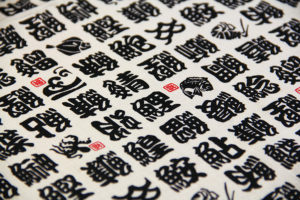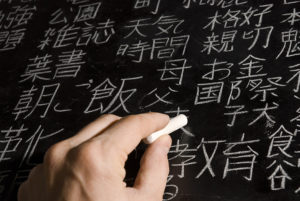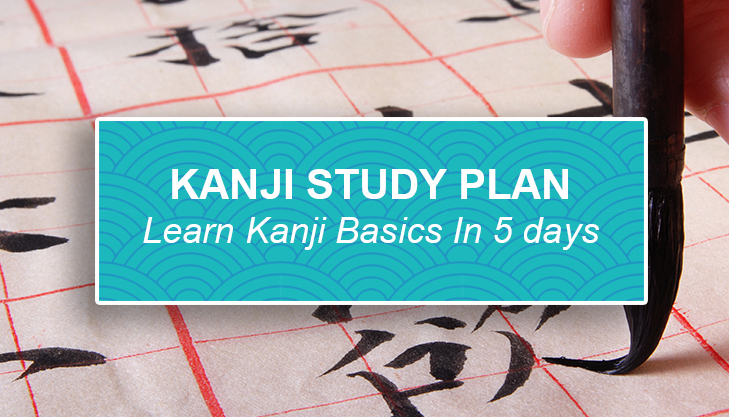By now, you’ve got a good grasp on hiragana and katakana so it’s time to begin your kanji self study routine. Good work getting this far! There are multiple paths you can take from here, so to make it through kanji you will need to be organised and have a great plan of attack.
The most important things you will need learning Kanji is patience and determination. The amount of sheer memorisation involved is huge so having interesting ways to study and a good routine will help you avoid burning out!
Lots of kanji to learn and no time to waste so let’s get into it!
Before you start the kanji self study routine.



You too could learn all of these kanji and more for the low low price of your soul!
To get to this point I’ll assume you’ve already completed the 7 day hiragana guide and the 7 day katakana guide. You really need to be completely familiar with both kana before jumping into kanji or you will have problems down the line.
If you want to spend some time learning some very basic vocabulary and grammar before you get stuck into kanji that will also give you a great foundation to learn with.
About the guide
This guide is not going to teach you kanji, it’s just a road map on where to focus, how to manage your time and how use your own study apps and books effectively.
This is just a starting point on your kanji learning journey. The majority of your time will just be spent memorising the characters but this guide will point you in the right direction and set you up into a study routine that you can continue going forward.
Remember your end goals.
Kanji isn’t something that needs to be included in every Japanese learners study plan. So if you’re only at the kanji stage because it’s “next” in the order things to learn, then you should consider your goals and decide whether it fits. It’s a shame to sink such a HUGE amount of time into kanji if you aren’t going to have any use for it at the end!
If you’re unsure if kanji works with your goals, have a read of my previous article to decide whether you REALLY need kanji.
Avoiding the slump.



Karen decided it was easier to hulk out rather than having to learn 2000 kanji.
With long terms study like this, it’s almost unavoidable to end up in a slump at some point. Inspiration and motivation come and go so the important thing is to figure out how to push through and keep going. That’s pretty personal as it involves figuring out your own motivations.
As you worked through kana, you have hopefully figured out what kind of study routine works well for you. Take this knowledge and use it to tailor your approach to kanji. Work at a time of day that you feel the most alert, have music to get you in the mood and take regular breaks to refresh your mind.
The routine of study is even more important in kanji because this is a much longer term project. If you need some more tips, read through my article on how to avoid getting overwhelmed learning Japanese.
Don’t study kanji in a vacuum.
It’s pretty tempting to think “Ok I’ll devote myself fully to kanji for a year and then move on to vocabulary and grammar once I’m done”. Studying this way is so much harder because you won’t be able to link concepts together to memorise them. Flash cards are good but being able to read kanji in the wild or in a book and link it to an experience is much more effective at sealing it in your memory.
On this note, I highly suggest using a program that includes vocabulary WITH your kanji learning. By learning vocabulary items that contain your kanji, you memorising things that are more useful in every day life and also reenforce the kanji you know.
Personally I think it’s best to alternate concentration between levels of kanji and grammar as it feels like you have a fuller understanding of the language. It also makes you feel like you’re progressing a lot faster!
Budget your resources: time and financial!
Kanji is the hardest part of Japanese. Frankly it’s tedious and very easy to burn out on. As such I think it’s important to use every resource you have at your disposal to get through it. If you’ve been saving your money, now is the time to start using it! Buy which ever apps or resources you think will help you stick with it to the end.
You will also need to start budgeting your time efficiently. When you were just tackling kana, it was easy to revise things in a few minutes a day. Kanji study is cumulative and you will need to adjust your routine to make sure you cover everything. If you are also studying grammar and vocabulary this can really blow your timelines out!
This study plan aims for around 30-35 minutes a day but you should adjust that to your own learning speed and schedule.
Now let’s get to the first day!
![]()
![]()
![]()
![]()
![]()
![]()
![]()
![]()
![]()
Kanji Self Study Routine
![]()
![]()
![]()
![]()
![]()
![]()
![]()
![]()
![]()



Julie was all ready to go in her kanji self study, just as soon as she returned her overdue library books.
Kanji Day 1 – Wtf is kanji.
Kanji are basically characters (originating from China) that represent entire words or ideas. They are incorporated into Japanese either alone or with hiragana attached. While hiragana and katakana are used often, without kanji knowledge you will never be able to read entire sentences.
Key study points:
How does kanji work?
Kanji is a bit harder than kana because each character represents a concept, and characters can have multiple meanings and pronunciations based on context. Combining 2 kanji can result in a word with a different meaning. We will cover the idea of readings tomorrow but today you should just get a basic understanding of how kanji works.
Kanji are used alone, together or in conjunction with hiragana to represent words. There are no spaces between words in Japanese so hiragana particles break up the kanji.
For example:
Japanese: 今日は日本語を勉強しています。
Romanji: Kyou wa nihongo wo benkyoushite imasu.
English: Today I’m learning Japanese.
In that sentence, the words for “today”, “Japanese” and “study” are all made of kanji which is broken up by hiragana.
The word 今日 means today, the reading is きょう (kyou). It’s made up of 2 kanji which individually represent “now” and “day”. Those two kanji have their own readings/meanings when used individually but when used together they are read as “kyou”.
So to know that part of the sentence, you would need to learn the 今 and 日 kanji characters, their individual readings, then them together as the vocabulary word with pronunciation.
Sound complicated? It’s not as bad as my terrible explanation makes it but there is a lot to remember. Check the suggested reading article in today’s study break down and from there, do your own research online until you have a good grasp on how kanji is used in sentences.
Choosing your study resources.
I haven’t written out a full guide on recommended kanji study apps yet but I will update here once it’s complete. In the mean time you should look for an SRS app that has mnemonics, revision and type in answers (not just flash cards). Ideally you want it to have simple levels so you can measure your progress and the ability to pause revisions in case you need a break.
I’m currently using Wanikani which has all of those features. The main downside to Wanikani is the price and that there is no official app currently. The mobile versions of the website are ok but it’s a lot easier to use the desktop version. The benefits far out weight the negatives though so have a look as the first 3 levels are free.
Study time break down:
- Research and choose your study apps – 15min
- Research and understand how kanji is used in Japanese sentences by reading Tae Kim’s guide or similar guides- 15min
![]()
![]()
![]()
![]()
![]()
![]()
![]()
![]()
![]()
Kanji Day 2 – Readings



Maybe stick to pen and paper, chalk seems a bit counter productive… but you do you.
Today we’ll be learning all about kanji readings and the differences between them so buckle in!
Key study points:
Readings
So as you saw in yesterdays’s guide, for each kanji you learn there are quite a few different things to memorise.
Each character usually has 2 kinds of reading:
Kun-yomi- Japanese readings, usually used for words that only have 1 character.
On-yomi- Chinese original readings, usually used for words with multiple characters.
I’m using the word “usually” a lot here because like all language rules: they are more like guidelines and there are exceptions.
For example:
Character: 日
Meaning: Sun/Day
On yomi- にち, じつ
Kun yomi- ひ, か, び
To make all of this easier, hopefully your study app has good mnemonics that include the readings and meanings together. That will save you a lot of time and trouble! In terms of studying, it’s most useful to learn matching vocabulary with kanji as you go so you can cement the readings with different words.
Setting long and short term goals
At this point you should also begin setting your kanji goals. Figure out what level you are working towards, when your end date is and how many kanji you need to achieve that. Next use that data to decide how many new characters you need to learn every day. I suggest giving yourself some breathing room and trying to finish 1 month before your actual end date so if you need to take time out you aren’t pushing yourself.
If you want to figure out how long it would take you to learn kanji check in here.
Take your schedule into account and set a long term and short term goals.
Long term goal – Complete N1 kanji by X date.
Short term goal – Learn 10 words per day plus revisions.
Study time break down:
- Learn about kun-yomi and on-yomi readings by reading Tofugu’s guide – 15min
- Set your goals – 15min
![]()
![]()
![]()
![]()
![]()
![]()
![]()
![]()
![]()
Kanji Day 3 – Radicals



Kanji radicals are about as radical as this sweet virtual reality set.
Well done on making it so far, this is the last day before you jump into actual kanji! Today we are learning about kanji radicals which are the building blocks that make up characters.
Key study points:
Radicals
So you’ve seen some kanji at this point and they are all looking a bit the same by now… that’s because most kanji are made up from roughly the same set of simpler characters. The simple characters are called radicals and it’s a common teaching technique to learn the radicals before you learn proper kanji.
By learning the radicals you set yourself up to be able to use their meanings in mnemonics when you learn kanji. This can be really useful as it helps you to “read” the characters and guess their meanings more easily.
The downside of this is that you then are adding a few hundred more characters to your learning list. Radicals don’t have pronunciations so at least it’s one less thing to learn. Have a read about them and think about whether this is something that you would find helpful or just tedious.
Study time break down:
- Learn about Radicals by reading the Tofugu article – 15min
- Read through a list of most common radicals to familiarise yourself – 15min
![]()
![]()
![]()
![]()
![]()
![]()
![]()
![]()
![]()
Kanji Day 4 – Learning your first Kanji



After about 500 kanji learned, Justine was even dreaming in Japanese. Bad dreams, but it’s still a step forward…
Well done on making it into the actual kanji phase! By now you should have a grip of what kanji is, how it’s used and how long it’s going to take you to achieve your goals.
Key study points:
Start learning!
So now it’s time to use whatever learning app you chose to start burning through the kanji! Ideally to make good speed, I suggest aiming to learn 10 kanji or radicals per day but it’s totally up to you and your schedule.
Mixing in grammar and other learning.
Remember when I said not to learn kanji in a vacuum? Now is the time to put it into practice. Break up your study by doing something OTHER than straight up kanji. Learn some grammar, read a book, watch tv, do literally anything else you like to keep things interesting.
Study time break down:
- Learn 10 new kanji – 15min
- Learn some new grammar or other non-kanji Japanese – 15min
![]()
![]()
![]()
![]()
![]()
![]()
![]()
![]()
![]()
Kanji Day 5 – Your average day – Learn and revise



“How do I say you have terrible breath in Japanese?” Kylie asked.
Today is the the last day in the guide and it’s the day which you will repeat for most of the rest of your study. Up until now you’ve been learning about kanji, from this point on it’s really just about getting it all into your brain.
Key study points:
Learning.
Every day try to aim to hit your goal of characters learned!
Revisions and mini revisions.
Revision can mean a lot of things. For the most part to progress in your app you will probably need to do a certain amount of standard multiple choice questions or type in answers. Don’t limit yourself to that though. Write characters down, use them to talk to friends, recognise characters in subtitles etc.
It’s also great if you can do mini reviews like you were doing with kana. If you can, do the revisions your app requires in bites of 5-10min throughout the day and then using your study revision time to do something fun.
Study time break down:
- Learn 10 new kanji – 15min
- Revise the kanji – 10min
- Grammar/reading/tv/anything else – 10min
![]()
![]()
![]()
![]()
![]()
![]()
![]()
![]()
![]()
Where do we go from here?



You too will be this appropriately happy once you finish your 2000 Kanji. Everyone will also have coffee for some reason. I don’t know.
Well done on making it through the kanji self study routine basics! Now it’s up to you to repeat Day 5 and keep learning!
You should have your goal plan set out and rewards along the way as you hit your targets so there’s not much left to tell you other than to keep going!
What about grammar and vocabulary?
Grammar and vocab are just as important as kanji so we will tackle them next and I’ll put together a full timeline of my guides to learning Japanese.
For now, stick to learning your kanji so you have a good base, I suggest at least finishing up to N5 level before you get into too much grammar. By learning some kanji before you get stuck into grammar you will find it a lot easier eventually read and understand.
The main take away here is to keep pushing through. While it does seem insurmountable, keep chipping away at kanji until you reach the end and you’ll be fluent in no time.
Now get to the other 1990 kanji!




